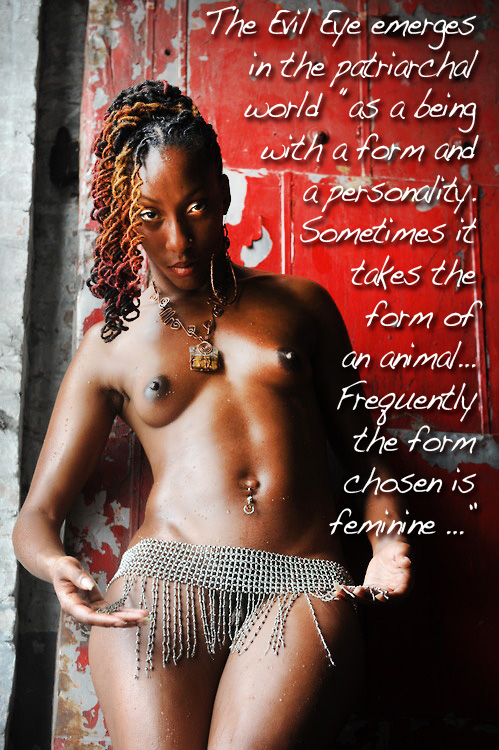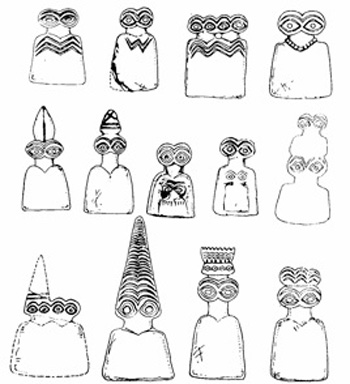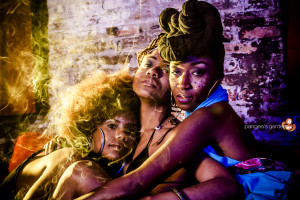The eyes are the most exclusive feature of the hundreds of votive figures found in the excavation of the Syrian “Eye Temple” of Tell Brak, a temple that was exclusively “dedicated to the worship of Ishtar (Inanna).” (13) The eye-idols, as they are known, are representations of Ishtar. The variations on their single iconographic form are almost without end. Some of the figures don headdresses, some wear necklaces, others are decorated with chevrons suggestive of breasts, and there are others whose necks and heads are abstracted phallic or vulvar forms. Each is unique and yet they are the same. These fascinating eye-idols, which date from about 3500-3300 B.C.E., are more ancient “than the pyramids of Giza and the whole of [the] Minoan culture of Cnossus.” (14)

It seems reasonable to suggest that the images of Ishtar served a prophylactic function. In later times, and with much the same intent, the Great Goddess was invoked under a variety of names in prayers against the Evil Eye of jealousy and envy. This is the purpose of a fourth or fifth Century C.E. Greek Orthodox incantation, which although addressed to the Father-god, calls upon the intercession of the virgin-goddess, Mary, for protection from such evil:
… Lord our God, have mercy on Thy creature and deliver Thy servant
from all harm, from all abuse and from all witchery, and keep him and
us above all evil, through the intercession of our most highly blessed,
illustrious mistress, the Mother of God and Eternal Virgin Mary … . (15)
In Christianized Scotland, charms against fascination asked the Pagan goddess Bridget’s aid as well as that of the Virgin Mary’s. (16) For protection from the Evil Eye, the Greeks and Romans prevailed upon Nemesis (17) (“Divine Vengeance”), the Goddess of Fate whose emblematic Wheel of Life stood for the solar year. Her power was omnipotent, for “when the wheel had turned half-circle, the sacred king, raised to the summit of his fortune, was fated to die … .” (18)
Jews throughout the Medieval world were so influenced by the Pagan views of the Evil Eye in Palestine and elsewhere, that it became customary to “append a prophylactic phrase … to every laudatory remark.” (19) The Hebrew phrase, ‘kein ayin ho’roh’, which means “may the evil be averted,” and its Yiddish equivalent,‘unbeschrieen’, are still in use today. The mezuzah (‘doorpost’), a parchment concealed in a protective case, which is displayed on the doorposts of Orthodox Jewish homes, is itself a prophylactic against the Evil Eye. (20) The parchment is inscribed with the texts of Deuteronomy 6:4-9 and 11:13-21 admonishing the children of Israel to keep God’s commandments, commandments directed against the sins of envy and jealousy by a jealous and vengeful god.
The goddess and her earthly manifestations are the more universally acknowledged magical sources for repelling injury from the Evil Eye and, simultaneously, held to be the very embodiments of evil. This seemingly paradoxical nature describes a numinous being in whom opposite elements co-exist in perfect harmony and wholeness. Predictably, as patriarchal ideals evolved, only the “negative” aspects of the goddess were promoted. Thus does Tiamat, the Sumerian Goddess of Creation who holds the Tablets of Fate in her hands, become the personification of evil. Lilith, the goddess to whom the owl with its glaring eyes is sacred, is regarded as little more than the “night-hag of the Hebrews”. (21) In Hinduism and Buddhism, Maya, the “great weaver of life,” (22)and the incarnation of all earthly women, is symbolized as the “Veil of Illusion” which tantalizes all mortals with wickedness and carnal lust.
Women are the weavers of spells, the workers of magic, from the earliest known myths of Sumer to the fairy tales of modern Europe. (23) Because the Evil Eye is identified with the “ensnaring” aspects of the Feminine, it is equated with the birth-giving womb of the so-called “Terrible Goddess” (24) through whom consciousness is attained. With similar intent, the woven knot as a universal symbol of the enchantress is equally powerful as a symbol of protection against her fascination, for she is not only the goddess of death but the ever-creating goddess of life and rebirth.
The Evil Eye emerges in the patriarchal world “as a being with a form and a personality. Sometimes it takes the form of an animal… . Frequently the form chosen is feminine … .” (25) The sacred animals of the Great Goddess, the representative emblems and vehicles of her power, were denigrated as objects of terror and evil, as monsters to be slain. Not surprisingly, the theriomorphic (animal-shaped) amulets employed as a specific protection against the Evil Eye are those of a kind widely associated with fertility and rebirth and of particular sacred significance to the goddess.
Athene’s sacred owl, universally described as a bird of ill-omen, appeared in Classical times as a prophylactic against the Evil Eye. (26) Hera (Juno), who has come down in the libelous patriarchal myths as “the most envious and ill-natured of the deities,” (27) was symbolized by the peacock, a bird that was believed to be the very embodiment of the Evil Eye. But of all the beasts, the serpent has fared the worst, for it has “always had a reputation for having the power to fascinate.”(28)
As the symbol of Hekate, the “goddess of witchcraft and sorcery,” (29) and of the hideously beautiful Gorgon Medusa, who turned to stone those who caught her gaze, the serpent, a symbol par excellence of wisdom, is both a terrifying symbol of evil and the mightiest of its antidotes. (30) The Greek Gorgoneion (from the Greek gorgos, ‘terrible’, ‘fierce’) was the earliest of all amulets against the dread of the Evil Eye. “Of all the possessors of the evil eye,” (31) the Gorgon Medusa was the most frequently encountered in Greek art. Medusa’s ability to turn men into stone has the same “anesthetizing effect” that the “witch’s spell exerts on … conscious-ness.” (32) The “paralyzing and petrifying effect of the hideous death mask” (33) is revealed in the story of Medusa’s eye magic. About the triple Gorgons, it is said:
They slay by a malign effluence, and this effluence, tradition said, came
from their eyes… . The Gorgon was regarded as a sort of incarnate Evil
Eye. The monster was tricked out with cruel tusks and snakes, but it slew
by the eye, it fascinated. (34)

Mesopotamian Eye-Idols representing Ishtar. From Her “Eye Temple” at Tell Brak, Syria.
The essential nature of fascination is such that it ultimately has the power to induce true consciousness, for it is by threading one’s way through the serpentine maze of the unconscious, often gynomorphized in the figure of the Great Goddess, that wisdom comes. From this dark and secret inner world she reveals her mysteries, bringing consciousness and the enlightenment of wisdom to those who realize that “… wisdom is better than rubies; and all the things that may be desired are not to be compared to it.” (35) Wisdom herself speaks of this, saying, “That I may cause those that love me to inherit substance; and I will fill their treasures.”(36)
The gaze of the Great Mother as Eye Goddess spans the centuries, holding spellbound for a time those who look upon her. As a symbol of perception and therefore of “seeing,” the eye was the natural emblem of the deity through whom consciousness was attained. Even after her formal worship was suppressed, the remnants of goddess worship, most especially in the practice of eye magic, endured in relatively “primitive” countries, where a noticeable presence of amuletic Evil Eyes remained. “Superstition,” as it is sometimes called, is a rather widespread phenomenon among even “civilized” peoples. We rather frequently “knock on wood” in a gesture that affords us mysterious protection. And we cross our fingers, unknowingly binding ourselves to the Goddess of the Knot – the Goddess of Destiny – whom we silently invoke.
2. Sir E. A. Wallis Budge, Amulets and Talismans. (New Hyde Park, NY: University Books, 1968), p. 358.
3. Frederick T. Elworthy, “Evil Eye”, in Encyclopaedia of Religion and Ethics. Twelve Volumes + One Volume Index. James Hastings, Editor. (Edinburgh: T. & T. Clark, 1925), Vol. 5, p. 609.
4. Ibid., Vol. 5, p. 613.
5. Ibid., quot. Plutarch, Symposium, V,7.
6. Ibid., Vol. 5, p. 613.
7. Edward S. Gifford, Jr., M.D., The Evil Eye: Studies in the Folklore of Vision.(New York: The Macmillan Company, 1958), pp. 72-73.
8. Frederick T. Elworthy, “Evil Eye”, in Encyclopaedia of Religion and Ethics, op. cit., Vol. 5, p. 612. The adage “like cures like” (“similia similibus curantur”) is an age-old medical axiom.
9. O. G. S. Crawford, The Eye Goddess. (London: Phoenix House Ltd., 1957), p. 93.
10. Tracy Boyd, “The Eternal Weaver” at <www.sacredthreads.net> This article was originally published as: Buffie Johnson and Tracy Boyd, “The Eternal Weaver”, in Heresies: A Feminist Publication on Art and Politics, Issue 5, 1978.
11. Frederick Thomas Elworthy, The Evil Eye: The Origins and Practices of Superstition. (New York: The Julian Press, Inc., 1958), p. 132.
12. O. G. S. Crawford, The Eye Goddess, op. cit., p. 98.
13. Ibid., p. 25.
14. Ibid., p. 20.
15. Edward S. Gifford, Jr., M.D., The Evil Eye: Studies in the Folklore of Vision, op. cit., p. 56.
16. Ibid., p. 60.
17. Ibid., p. 55.
18. Robert Graves, The Greek Myths. Two Volumes. (Baltimore: Penguin Books, Inc., 1960), Vol. I, Section 32.1, p. 126.
19. Joshua Trachtenberg, Jewish Magic and Superstition: A Study in Folk Religion. (New York: Atheneum, 1975), p. 55.
20. Frederick T. Elworthy, “Evil Eye”, in Encyclopaedia of Religion and Ethics, op. cit., Vol. 5, p. 613.
21. Sir E. A. Wallis Budge, Amulets and Talismans, op. cit., p. 357.
- 22. Erich Neumann, The Great Mother: An Analysis of the Archetype. Trans. Ralph Manheim (Princeton: Princeton University Press, Bollingen Series XLVII, 1970), p. 227.
- 23.Tracy Boyd, “The Eternal Weaver” at <www.sacredthreads.net>
24. See: Erich Neumann, The Great Mother: An Analysis of the Archetype, op. cit., Chapter 11, “The Negative Elementary Character”, pp. 147-208 passim.
25. Sir E. A. Wallis Budge, Amulets and Talismans, op. cit., pp. 356-57.
26. Jane Ellen Harrison, Prolegomena to the Study of Greek Religion. (New York: Meridian Books, 1955. Reprinted from the Cambridge University Press editions: 1st of 1903, 2nd of 1908, and 3rd of 1922), p. 197.
27. Frederick T. Elworthy, “Evil Eye”, in Encyclopaedia of Religion and Ethics, op. cit., Vol. 5, p. 610.
28. Ibid.
29. Martin P. Nilsson, Greek Folk Religion. (Philadelphia: University of Pennsylvania Press, 1972), p. 90.
30. Frederick Thomas Elworthy, The Evil Eye: The Origins and Practices of Superstition, op. cit., p. 132.
31. Frederick T. Elworthy, “Evil Eye”, in Encyclopaedia of Religion and Ethics, op. cit., Vol. 5, p. 609.
32. Ann Belford Ulanov, “The Witch Archetype”, in Quadrant: Journal of the C. G. Jung Foundation for Analytical Psychology, Vol. 10, No. 1, Summer 1977, p. 7.
33. Erich Neumann, The Origins and History of Consciousness. Trans. R. F. C. Hull. Bollingen Series XLII. (New York: Pantheon Books, 1954), p. 215.
34. Jane Ellen Harrison, Prolegomena to the Study of Greek Religion, op. cit., pp. 195-96.
35. The Proverbs 8:11. King James Version.
36. The Proverbs 8:21. King James Version.
A freelance fitness/swimsuit and fine art model, Makeda Voletta is a trained and professional dancer in a variety of dance styles from the Carribean, South America, North America and Africa. She is a dedicated student of the body and all of the methods involved with bringing the body to it’s highest level. Makeda has a B.S. in Exercise and Sports Science with a concentration in Strength and Conditioning and a minor in Nutrition. Having completed two years of graduate work at Columbia University in Applied Physiology and Nutrition as well as plenty of self study, Makeda is a self-proclaimed body science nerd.









incredibly intriguing dialogue. I am interested in the relationship of this knowledge to the christian ethic of physical love.